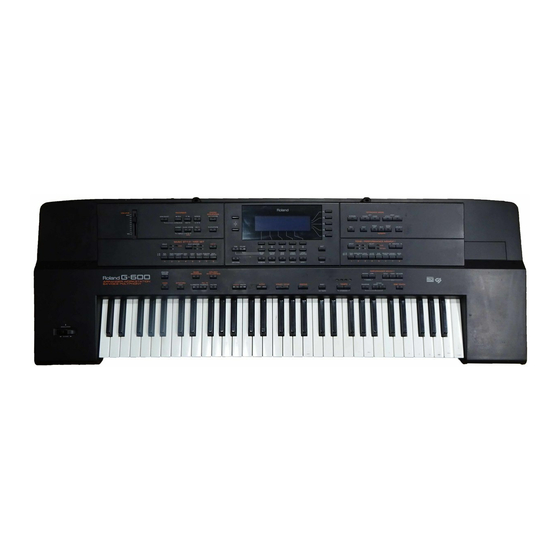
Roland G-600 Arranger Workstation Manuals
Manuals and User Guides for Roland G-600 Arranger Workstation. We have 1 Roland G-600 Arranger Workstation manual available for free PDF download: Owner's Manual
Roland G-600 Owner's Manual (229 pages)
Arranger workstation
Brand: Roland
|
Category: Electronic Keyboard
|
Size: 13.24 MB
Table of Contents
-
Contents9
-
Setting up14
-
Connections14
-
Demo Songs14
-
Front Panel16
-
Rear Panel19
-
Exit21
-
Master Page21
-
Upper2 Split29
-
Roll31
-
Master Tune39
-
Standard43
-
Piano Style43
-
Intelligent44
-
One Touch49
-
Fade out49
-
Style Tempo53
-
Tap Tempo53
-
Tone Change54
-
Resume61
-
Style Change66
-
You're on69
-
Song Volume76
-
Easy Editing77
-
Muting Parts80
-
Equalizer83
-
Part Editing86
-
Envelope88
-
Song Sets100
-
Concept102
-
Patterns102
-
Tracks102
-
Looped Divisions103
-
Record Mode107
-
Quantize107
-
Tone Selection108
-
Time Signature108
-
Tempo110
-
Recording110
-
Remarks112
-
Metronome112
-
Empty Tracks112
-
MIDI Channels119
-
Track Erase122
-
Track Delete122
-
Track Insert122
-
Track Transpose122
-
Track Shift123
-
Step Time Record124
-
MIDI127
-
MIDI in General127
-
MIDI Connectors127
-
MIDI Data127
-
MIDI Connections128
-
NTA Channel129
-
Basic Channel130
-
Local Function133
-
Rx Velo, TX Velo133
-
Soft Thru134
-
MIDI Sets135
-
Housekeeping137
-
General Remarks137
-
Compatibility140
-
Before You Start142
-
Global Volume144
-
Mixer Mode147
-
Mixer/Song Page148
-
Reverb Page148
-
Macro149
-
Chorus Page150
-
Delay Page151
-
Delay Parameters151
-
Equalizer Page151
-
Source Pages152
-
Parameter Mode153
-
Split (C3-C6)154
-
Song Set Play155
-
Transpose Mode156
-
Kbd Scale157
-
Sensitivity158
-
Pitch Bender159
-
Source\Tune Page160
-
User Style Mode162
-
Track162
-
Key164
-
(Metron) Mode164
-
(Quantize) Value164
-
Panpot165
-
Tone/Drum Set165
-
Length Pages167
-
Cpt168
-
Track Copy169
-
Edit\Velo\1 Page176
-
Edit\Velo\2 Page176
-
Edit\Velo\3 Page177
-
Style Name184
-
MIDI Mode185
-
MIDI/NTA Page191
-
MIDI Sync RX/TX194
-
Partswtc194
-
Disk Mode197
-
Load Style Set197
-
Load MIDI Set198
-
Save User Style199
-
Save MIDI Set199
-
Rename200
-
Rename Song201
-
Delete202
-
Style Set202
-
Song Set203
-
Copy Functions203
-
Disk Copy204
-
Disk Format205
-
Display Messages206
-
General Messages208
-
Tone Lists212
-
GM Tones216
-
Specifications218
-
Index219
Advertisement
